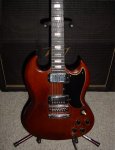toyL
Member

The last time I had my early 70s sg in the shop (Wayne Kamp's Custom Guitars) for a setup, he told me that the nut (bone) was pretty much worn down to the point that I should consider replacing it. He pointed out a
couple of the notches (the A and the low E) where he had built them "up"
using a small amount of some hardened synthetic material. On top of these
reworked notches he inserted a thin rectangular "medium-soft" plastic-like
material, under the string, that basically served to minimize string-wear on the hardened synthetic material that filled/raised the notches. All in all, he
had done a magnificent job, although it was clearly a temporary "fix"--
which he didn't feel the need to elaborate on because he knows me well
enough to know that I could plainly see it for what it was.
At the time, I could easily "see" the hardened synthetic filler he had ever so
neatly used too build up the worn notches, but I did NOT see the small thin
plastic-like inserts under the two strings. It wasn't until a few days later, when I was tuning down to play Zep's "In My Time of Dying" that I even noticed the thin plastic inserts. Tuning the top two strings down a whole step caused the plastic inserts to move slightly toward the bridge, which dramatically muffled/altered the intonation, rendering the guitar unplayable--except in standard tuning after tedious replacement of the plastic inserts under the strings at the nut.
So, does anyone know where I can get my hands on some old bone nut
pieces that can be re-worked to fit nicely on a fairly thin old Gibson SG
neck? I know that most of these particular guitars have been hacked-awayin order to salvage their fret-boards and pickups, so, I'm thinking there
might be a few nuts laying around as well. Thanks for any replies.
Attachments
Last edited:



 I was just wondering out load why anyone would put little lose pieces under the st string when its actually easier to fill the slot with bone dust and super glue and re cut the slot. This is a very common semi permanent fix that would seem easier if nothing else.
I was just wondering out load why anyone would put little lose pieces under the st string when its actually easier to fill the slot with bone dust and super glue and re cut the slot. This is a very common semi permanent fix that would seem easier if nothing else.